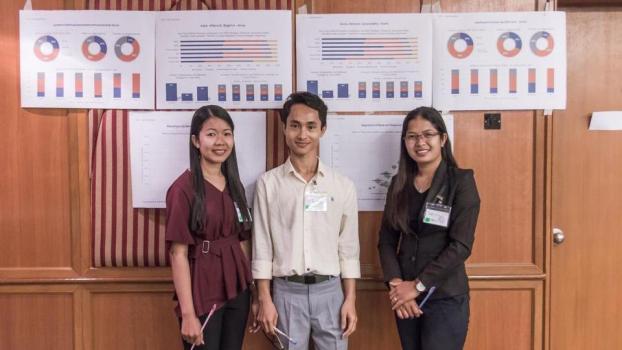How Network Analysis Can Forge a Stronger Sanitation Sector
Challenges to improving rural sanitation in Cambodia remain immense, where, as of 2015, approximately 50 percent of rural residents still practiced open defecation. New efforts and approaches are needed to achieve the country’s long-term vision for improvements in the sanitation sector, which includes sustainable access to sanitation services for all Cambodians.
As part of the USAID Sustainable WASH Systems (SWS) Learning Partnership, WaterSHED is supporting a locally led and owned approach to increase the sustainability of sanitation and hygiene services in rural Cambodia. Its approach—based on the tenets of collective impact—brings together a wide range of stakeholders, including government, private sector, NGOs, and donors, to develop a shared vision for how to improve services and strengthen the sanitation and hygiene sector.
WaterSHED believes that many of the solutions needed to make sanitation and hygiene sustainable in rural Cambodia already exist within the network of actors working in the sector. If everyone worked more collaboratively and effectively toward a common vision, sustainable sanitation for all could be achieved.
The first step in WaterSHED’s approach is to help sector actors better understand the network within which they operate. To achieve this, WaterSHED worked with LINC to perform an initial Organization Network Analysis (ONA), which included conducting and analyzing interviews with network actors. In defining the network, WaterSHED cast a wide and inclusive net, including 88 organizations working on rural sanitation and hygiene.
In December 2017, WaterSHED convened more than 100 sector stakeholders from the government, NGO community, and development partners to share the results of the ONA and garner feedback on WaterSHED’s interpretation of the findings. Through our role in SWS, we participated in this workshop, where the following findings were presented:
- The ONA uncovered many attributes of a well-functioning network. Most organizations are well connected to each other, resulting in few isolated organizations; the lead government office for the sector, the Ministry of Rural Development (MRD), plays the most central role within the network—75 of the 88 organizations surveyed are directly connected to MRD. A key question is how the sector can make use of this well-connected network to better coordinate and align activities.
- Multiple subclusters of strongly connected organizations are focusing on key issues. One such group is made up of 22 organizations, including private sector, NGO, and development partners, that are focused primarily on sanitation financing and market development. We may be able to learn from these clusters to tackle new challenges within the sector.
- The analysis identified areas where network strengthening could improve sector coordination and effectiveness. Local NGOs are less well-connected to each other—they tend to be connected primarily through an intermediary, such as government ministries or international NGOs. The same is true of private sector entities. These findings raise questions of how better connected local NGOs or private sector entities might benefit the sector: Could better connected local NGOs share lessons regarding common challenges and solutions? Might a more connected private sector benefit from economies of scale, with respect to supplies, marketing, and other functions?
- The sector may be biased toward English-English communication, which might marginalize some local organizations. The ONA found correlations between the connectivity of those organizations that chose to be interviewed in Khmer versus in English. Actors who were interviewed in English were more likely to be connected to one another than actors who were interviewed in Khmer. This may result from coordination activities being conducted primarily in English, creating a barrier to entry for Khmer-operating organizations.
These are just a few of the findings and questions that WaterSHED, LINC, and other local actors will continue to explore as they analyze the ONA results and the feedback received earlier this month. ONA is just one early step in WaterSHED’s broader collective impact process. Moving forward, the findings from this analysis will be used to decide where and how to strategically provide support to strengthen the sector network, ultimately seeking to improve the sustainability of rural sanitation and hygiene services.
By Daniel Hollander, Deputy Chief of Party, Sustainable WASH Systems Learning Partnership, and Elizabeth Jordan, USAID Water and Sanitation Advisor
The USAID Sustainable WASH Systems Learning Partnership is a global USAID cooperative agreement aimed at developing, demonstrating, learning about, and sharing evidence on systems-based approaches for improving the sustainability of WASH services. With implementation of systems-based approaches in Cambodia, Ethiopia, Kenya, and Uganda, USAID will gain an understanding of how, and under what conditions, these approaches can be effectively applied in future programs.
For more information about the SWS Learning Partnership, visit http://www.globalwaters.org/SWS.


